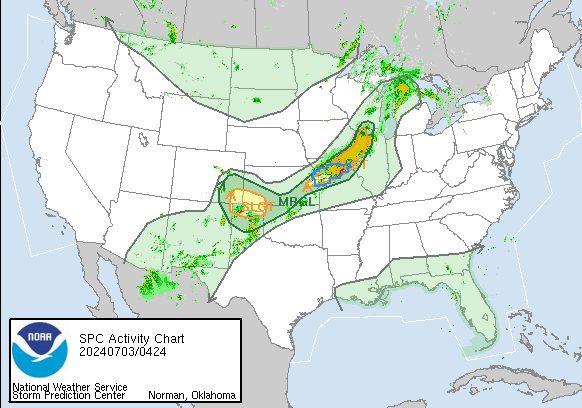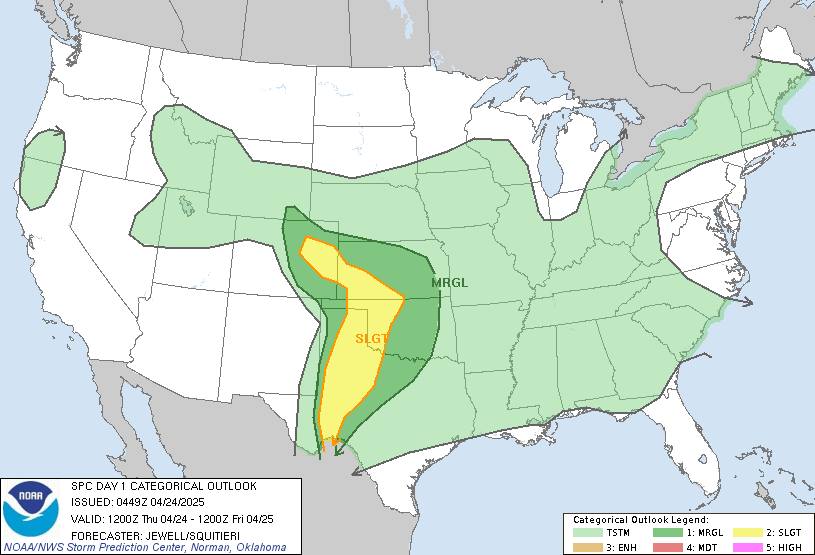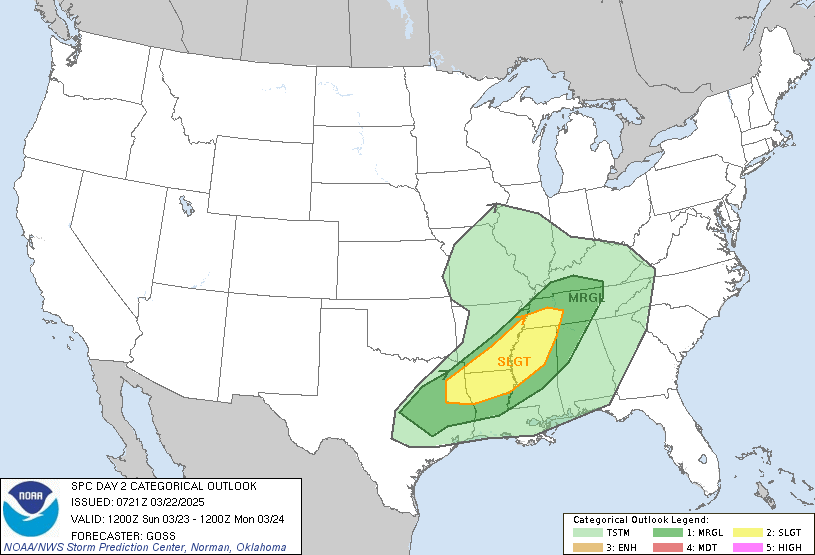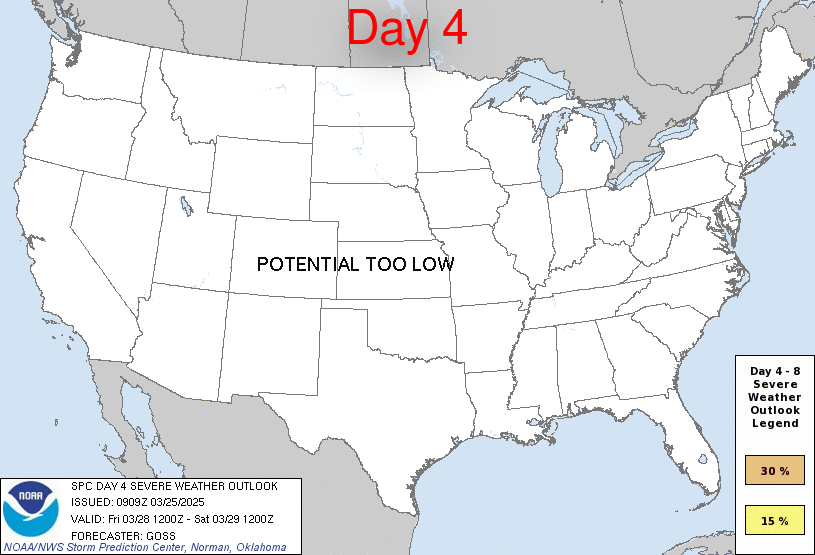The Storm Prediction Center convective weather outlook is part of the National Weather Service (NWS) and the National Center for Environmental Prediction (NCEP). Their mission is to provide accurate forecasts and monitor the timing of thunderstorms and severe storms in the United States. The SPC provides convective outlooks on Day 1, Day 2, and Day 3 that reflect the overall level of severe weather hazard outlooks through a list of forecast statistics. This data identifies areas at risk of mild thunderstorms and severe thunderstorms. For more information on how to read this map, please see the bottom of this page.

Convective Outlook Day 1

SPC Day 1 Outlook Discussion
ACUS01 KWNS 020026 SWODY1 SPC AC 020025 Day 1 Convective Outlook NWS Storm Prediction Center Norman OK 0625 PM CST Thu Jan 01 2026 Valid 020100Z - 021200Z ...NO THUNDERSTORM AREAS FORECAST... ...SUMMARY... Thunderstorms are not forecast tonight. ...01z Update... Upper low/short-wave trough have advanced inland across interior CA early this evening. Earlier isolated thunderstorm activity, beneath this feature, has weakened and further boundary-layer cooling will not prove beneficial for deep convection capable of generating lightning. ..Darrow.. 01/02/2026 $$ |
Convective Outlook Day 2

SPC Day 2 Outlook Discussion
ACUS02 KWNS 011714 SWODY2 SPC AC 011712 Day 2 Convective Outlook NWS Storm Prediction Center Norman OK 1112 AM CST Thu Jan 01 2026 Valid 021200Z - 031200Z ...NO SEVERE THUNDERSTORM AREAS FORECAST... ...SUMMARY... Severe thunderstorm potential appears low on Friday. ...Central Gulf Coast and Deep South... A low-amplitude midlevel shortwave trough will move from the south-central Plains toward the TN Valley through the period, while a somewhat more vigorous shortwave progresses east-southeastward from the Four Corners region toward the lower MS Valley. The combination of these features will result in an elongated surface low that will extend from northern MS/AL toward southern LA by Friday evening. Returning low-level moisture will result in a somewhat conditionally favorable environment Friday afternoon from parts of LA into southern MS, as MLCAPE increases to around 500 J/kg amid strengthening deep-layer shear. However, poor midlevel lapse rates and generally weak ascent across the warm sector may tend to limit surface-based storm potential, with most guidance showing no diurnal development across this area. A strengthening low-level jet will aid in the development of elevated convection Friday evening, mainly across parts of central/northern MS/AL/GA. Weak buoyancy should tend to limit the organized severe threat with any elevated storms. Convection may also tend to increase along the immediate central Gulf Coast near the end of the period, but warm midlevel temperatures are expected to limit storm depth and intensity in this area through 12Z Saturday morning. ...Northern CA into southwest OR... A deep mid/upper-level trough and embedded deep-layer cyclone will gradually approach the central and northern Pacific Coast through the period. Within the large-scale trough, an embedded vorticity maximum is forecast to approach northern CA and southwest OR by mid to late evening. Colder temperatures aloft and some steepening of midlevel lapse rates will overspread the region as this vorticity maximum moves through, which will increase the threat for sporadic lightning flashes with any stronger convective elements. Most CAM guidance depicts development of a narrow rain band in association with the lead vorticity maximum, which moves over immediate coastal regions between 03-06Z. This band may be coincident with gusty/locally damaging winds, given the strengthening background wind field (50+ kt at 850 mb). However, with stronger cooling aloft and steepening of low-level lapse rates generally only expected in the wake of this band, the extent to which any deeper convective processes contribute to wind-damage potential is uncertain and may remain limited. ..Dean.. 01/01/2026 $$ |
Convective Outlook Day 3

SPC Day 3 Outlook Discussion
ACUS03 KWNS 011930 SWODY3 SPC AC 011929 Day 3 Convective Outlook NWS Storm Prediction Center Norman OK 0129 PM CST Thu Jan 01 2026 Valid 031200Z - 041200Z ...THERE IS A MARGINAL RISK OF SEVERE THUNDERSTORMS FOR PARTS OF THE SOUTHEAST...AND ALSO FROM PARTS OF NORTHERN CA INTO COASTAL SOUTHWEST OR... ...SUMMARY... Isolated severe storms are possible across parts of the Southeast on Saturday, and the Sacramento and northern San Joaquin Valleys to coastal northern California-southwest Oregon during the late afternoon to evening. ...Parts of the Southeast... A positive-tilt mid/upper-level shortwave trough is forecast to move from the lower MS Valley toward the South Atlantic Coast through the period, as an attendant surface low moves from parts of AL/GA to offshore of SC by late evening. A trailing cold front will move through parts of the Southeast and central Gulf Coast vicinity. Guidance continues to vary regarding the timing of the front and extent of heating/destabilization across the warm sector, but a plume of weak to moderate MLCAPE is expected to be in place along/ahead of the cold front during the afternoon, as low-level moisture spreads northeastward. Some veering/weakening of low-level flow is forecast across parts of the warm sector with time (especially with southwestward extent), but increasing midlevel flow will result in sufficient effective shear for organized storms, including some supercell potential. Any lingering morning convection may intensify during the afternoon, with additional storm development expected along/ahead of the cold front, and near the primary buoyancy gradient and effective warm front. This activity could pose at least a low-probability threat for all severe hazards. A corridor of somewhat greater potential may evolve within the broader Marginal Risk area, though uncertainty remains regarding the magnitude of diurnal heating/destabilization, and the strength/timing of the primary shortwave trough as it moves quickly eastward. ...Northern CA to coastal southwest OR... Latest guidance still depicts potential for multiple shortwave troughs to eject northeastward from a deep mid/upper-level trough off of the Pacific Coast. The southernmost shortwave is forecast to move across central CA through the afternoon, while the more vigorous northern shortwave is expected to affect coastal OR from late afternoon into the evening. The southern shortwave will be favorably timed for diurnal convective development across the Sacramento and northern San Joaquin Valleys, where cooling midlevel temperatures (dropping below -20C at 500 mb) may support SBCAPE of 250-500 J/kg during the afternoon. With relatively elongated hodographs, this generally meager buoyancy may be sufficient for transient rotating cells to develop, which could pose a threat for a brief tornado, small hail, and locally gusty winds. The northern shortwave will be accompanied by a renewed strengthening of low-level flow, potentially increasing to near/above 60 kt at 850 mb over the ocean and along the northern CA/southwest OR coast. Buoyancy will remain meager, but cold temperatures aloft will support low-topped convection that could contribute to severe-gust potential. Transient rotating cells may also develop offshore and approach the coast. ..Dean.. 01/01/2026 $$ |
Convective Outlook Day 4-8

SPC Day 4-8 Outlook Discussion
ACUS48 KWNS 010935 SWOD48 SPC AC 010933 Day 4-8 Convective Outlook NWS Storm Prediction Center Norman OK 0333 AM CST Thu Jan 01 2026 Valid 041200Z - 091200Z ...DISCUSSION... Severe potential appears low through much of the period, with an increase possible late next week. While run-to-run predictability has been poor, latest guidance appears to be trending somewhat more consistently with the evolution of an upper trough off the West Coast. This feature may evolve as a lower-latitude wave across Baja CA and northern Mexico, or along the international border in the Southwest States, before eventually emerging near TX. While predictability is low for spatiotemporal aspects of this wave, it may eventually interact with a modifying warm-moist sector from the western Gulf into the South-Central States. SPC-CSU GEFS ML probs highlight a 5 percent on D8/Thursday (although seemingly biased too far north). Meanwhile, NSSL GEFS ML V1.2 probs highlight only a 2 percent on D8, but have a 10 percent on D9/Friday. ..Grams.. 01/01/2026
Convective Weather Outlook Legend Data
- TSTM (light green) – General or non-severe thunderstorms – Delineates, to the right of a line, where a 10% or greater probability of thunderstorms is forecast during the valid period.
- 1-MRGL (dark green) – Marginal risk – An area of severe storms of either limited organization and longevity, or very low coverage and marginal intensity.
- 2-SLGT (yellow) – Slight risk – An area of organized severe storms, which is not widespread in coverage with varying levels of intensity.
- 3-ENH (orange) – Enhanced risk – An area of greater (relative to Slight risk) severe storm coverage with varying levels of intensity.
- 4-MDT (red) – Moderate risk – An area where widespread severe weather with several tornadoes and/or numerous severe thunderstorms is likely, some of which should be intense. This risk is usually reserved for days with several supercells producing intense tornadoes and/or very large hail. Or an intense squall line with widespread damaging winds.
- 5-HIGH (magenta) – High risk – An area where a severe weather outbreak is expected from either numerous intense and long-tracked tornadoes. Also, a long-lived derecho-producing thunderstorm complex that produces hurricane-force wind gusts and widespread damage. This risk is reserved for when high confidence exists in widespread coverage of severe weather with embedded instances of extreme severe. (i.e., violent tornadoes or very damaging convective wind events).
This data is courtesy from the Storm Prediction Center

